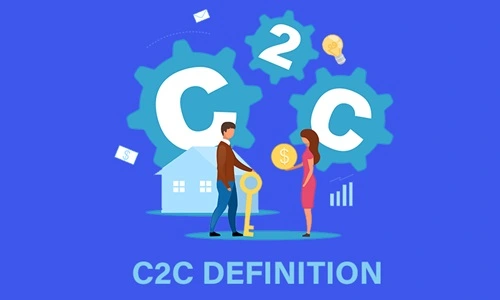C2C meaning is “consumer to consumer” or “customer to customer”. Before the internet was even a thing, you may have just heard of business models where one business transacts with another (B2B) or the business sells something to a customer (B2C), right? But have you heard of a business model where customers sell to other customers? Yes, that’s a thing, and it has grown super fast after the whole internet boom. Websites or platforms like eBay, Amazon, and Etsy are big examples of that. But if you want to know whether or not this C2C business model is any good then you should keep on reading this post. Here we are about to take a good look at what are the possible advantages and disadvantages of the C2C business model. Alright, here we go now.

Advantages of the C2C Business Model
1. Pocket-Friendly Prices for Buyers
As you may have guessed, one of the best things about the C2C business plan is that it helps buyers save money. Why and how? Because it gets rid of the middlemen, no more stores or wholesalers who raise prices. With this setup, sellers can offer their goods at prices that are usually a lot lower than in stores, you know?
2. More Profits for Sellers
People who sell things know that the C2C approach is like winning the lottery. Sellers keep more of the money they make because they don’t have to share it with middlemen or pay a lot to run expensive shops. Without a doubt, this is great for small-time hustlers or one-person businesses that are trying to make it big but aren’t able to afford it.
3. Massive Market Reach
Think big, not small! As they say, right? You see, C2C platforms break down geographical barriers, letting sellers meet with people all over the world. In contrast to a physical shop that can only attract people in the same area, these online marketplaces let you reach people all over the world, greatly increasing the number of people who can see and buy your products.
4. Trading on Your Terms
C2C sites are great for both buyers and sellers because they are flexible and easy to use. Want to buy something at midnight or sell something early in the morning? Well, not a problem at all. You can make transactions from anywhere, at any time, because these sites are always open. Plus, buyers can manage their stock and sales whenever they want!
5. Building Trust as a New Seller
For new people in the business scene, it can be hard to earn trust. You’re lucky that well-known C2C sites have your back. They often have systems that check out sellers and show reviews from customers, which helps new sellers quickly gain trust. And that’s the very reason why customers are more likely to buy from you if they see that you’re part of a site that they trust.
6. A Bunch Of Choices
It’s truly amazing how many different kinds of tools there are for C2C. For example, are you looking for something special or just looking around to get ideas? It’s likely that you’ll find it and more. With many sellers in one virtual place, buyers have a lot of options, which makes it easier than ever to find the best deal on the perfect item.
7. A Startup on a Tight Budget
Want to start your own business? It’s very cheap with C2C systems. You don’t even need to worry about big costs like renting a store or making a fancy front. It can be cheap to set up your online store on a C2C platform, which means you can spend more time doing what you love: selling and building your business.
Disadvantages of the C2C Business Model
1. Competition, Everywhere!
The C2C market is really busy, can you believe it? It seems like everyone is trying to sell something, and you could be selling the same thing! Because of all the competition, prices are slashed very low, leaving very little room for profit, and that’s kinda one of the biggest issues for the newcomers in this C2C scene.
2. The Problem with Quality Control
Quality control, or the lack of it, in the C2C approach is a huge pain. How and why? Since no one checks what’s being sold, the quality of the goods can go from great to scary. Buyers are often unhappy with this up-and-down ride of inconsistency, which can lead to bad reviews that can really hurt a seller’s reputation. As for buyers, if they don’t believe in the quality, they’ll likely not buy anything.
3. Tricky Payment Transactions
Not able to pay? They’re pretty big. There are a lot of risks, from the fear of fraud to the pain of payment scams where sellers never see the money or buyers never see the things they buy. Some sites do offer payment protection, but it’s not always the case, and you may end up being let down.
4. Those Annoying Platform Fees
See, sure, it may be cheap to get started in the world of C2C, but those site fees that you have to pay every month? They’ll get you. You lose money when you have to pay fees to list, sell, or do both. A smart seller would get these numbers and use them to set their prices unless they want to lose money on their sales.
5. Must Follow The Platform Policies
If you are out there wanting to become a C2C seller, well, you must keep in mind that there are things like platform policies that you must follow. You could wake up one morning to higher fees, weird computer behavior, or new rules that make things harder for you. The worst bit though? You have no say in these changes.
6. Customer Support? Good Luck With That
There are a lot of C2C tools that say “figure it out yourself” instead of “How can we help?” This do-it-yourself deal can go bad when there are problems, like when the product doesn’t work when delivery goes wrong, when there are payment problems, or anything like that.
Conclusion
All in all, if you can come up with some system or platform where customers can transact with or sell products to other customers, then you are pretty much good to go. However, there are challenges that we already mentioned above, overcome those, and you’ll be good for the most part.

